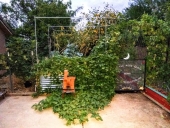
 2
2








 2
2




Sometimes the answer is nothing

 1
1








Huxley Harter wrote:I personally would not use them at all for anything in contact with the ground or near high traffic areas IF they are lead positive. If so, I would test the soil for lead.




wayne fajkus wrote:Lead paint was banned in 1978(USA). I'm sure thiere was carryover from gallons sitting in garages, but sounds like you have a good 20 year cushion




Gabe Smith wrote:From what I can tell from the second picture, those 4"*4"posts that go into the ground are most likely pressure treated. If the boards are in contact with the ground in any way, and you do not see evidence of decomposition, they are likely pressure treated. Unless those are black locust, untreated wood will begin decaying pretty much within a year if it is contact with soil. If they are older than about 20 years, they will likely be the kind that was pressure treated with arsenic. The newer pressure treated is still toxic, but not quite as bad. If they are pressure treated, they probably leach into the soul only if they are the new style that actually rots eventually. I believe some sort of copper compound. I would say that any scraping or standing,even if the paint is latex paint, will inevitably find it's way into your soil. Personally, I would not bother with the hassle of testing, etc. I would remove them entirely.

| I agree. Here's the link: http://stoves2.com |



